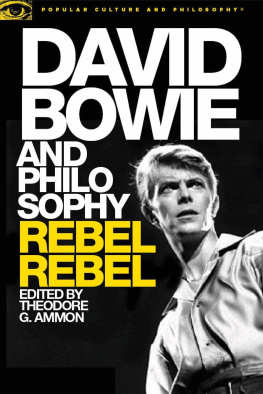Pat Gilbert - Bowie: The Illustrated Story
Here you can read online Pat Gilbert - Bowie: The Illustrated Story full text of the book (entire story) in english for free. Download pdf and epub, get meaning, cover and reviews about this ebook. year: 2017, publisher: Voyageur Press, genre: Non-fiction. Description of the work, (preface) as well as reviews are available. Best literature library LitArk.com created for fans of good reading and offers a wide selection of genres:
Romance novel
Science fiction
Adventure
Detective
Science
History
Home and family
Prose
Art
Politics
Computer
Non-fiction
Religion
Business
Children
Humor
Choose a favorite category and find really read worthwhile books. Enjoy immersion in the world of imagination, feel the emotions of the characters or learn something new for yourself, make an fascinating discovery.

- Book:Bowie: The Illustrated Story
- Author:
- Publisher:Voyageur Press
- Genre:
- Year:2017
- Rating:3 / 5
- Favourites:Add to favourites
- Your mark:
Bowie: The Illustrated Story: summary, description and annotation
We offer to read an annotation, description, summary or preface (depends on what the author of the book "Bowie: The Illustrated Story" wrote himself). If you haven't found the necessary information about the book — write in the comments, we will try to find it.
Follow every step of David Bowies career; from Ziggy Stardust to Tin Machine, from Space Oddity to Lets Dance to Blackstar, in Bowie: The Illustrated Story. David Bowie released an incredible 27 studio albums, beginning with his eponymous 1967 debut and ending with Blackstar, released just two days before his untimely death in January 2016. Widely regarded as one of the most influential musicians and performers of the previous five decades, Bowie demolished what were thought to be the limitations of stagecraft in rock music, as well as proving it possible for an artist to constantly--and successfully--redefine himself. As a result, Bowie has been credited with inspiring genres as disparate as glam and punk rock. This sharply written and gorgeously designed retrospective follows Bowies career from the folkie baroque rock of his debut, to his breakthrough single Space Oddity, and on to his flamboyant glam rock alter ego, Ziggy Stardust. Author Pat Gilbert continues through Bowies soul phase, his electronic Berlin trilogy, his massive pop success in the 1980s, and his turn to electronica in the 1990s, as well as subsequent tours, notable performances, collaborations, and accolades. Nearly every page is illustrated with stunning concert and candid offstage photography, including gig posters, 7-inch picture sleeves, concert ticket stubs, and more. The result is a fitting tribute to one of the most influential and admired stars in rock history.
Pat Gilbert: author's other books
Who wrote Bowie: The Illustrated Story? Find out the surname, the name of the author of the book and a list of all author's works by series.

















